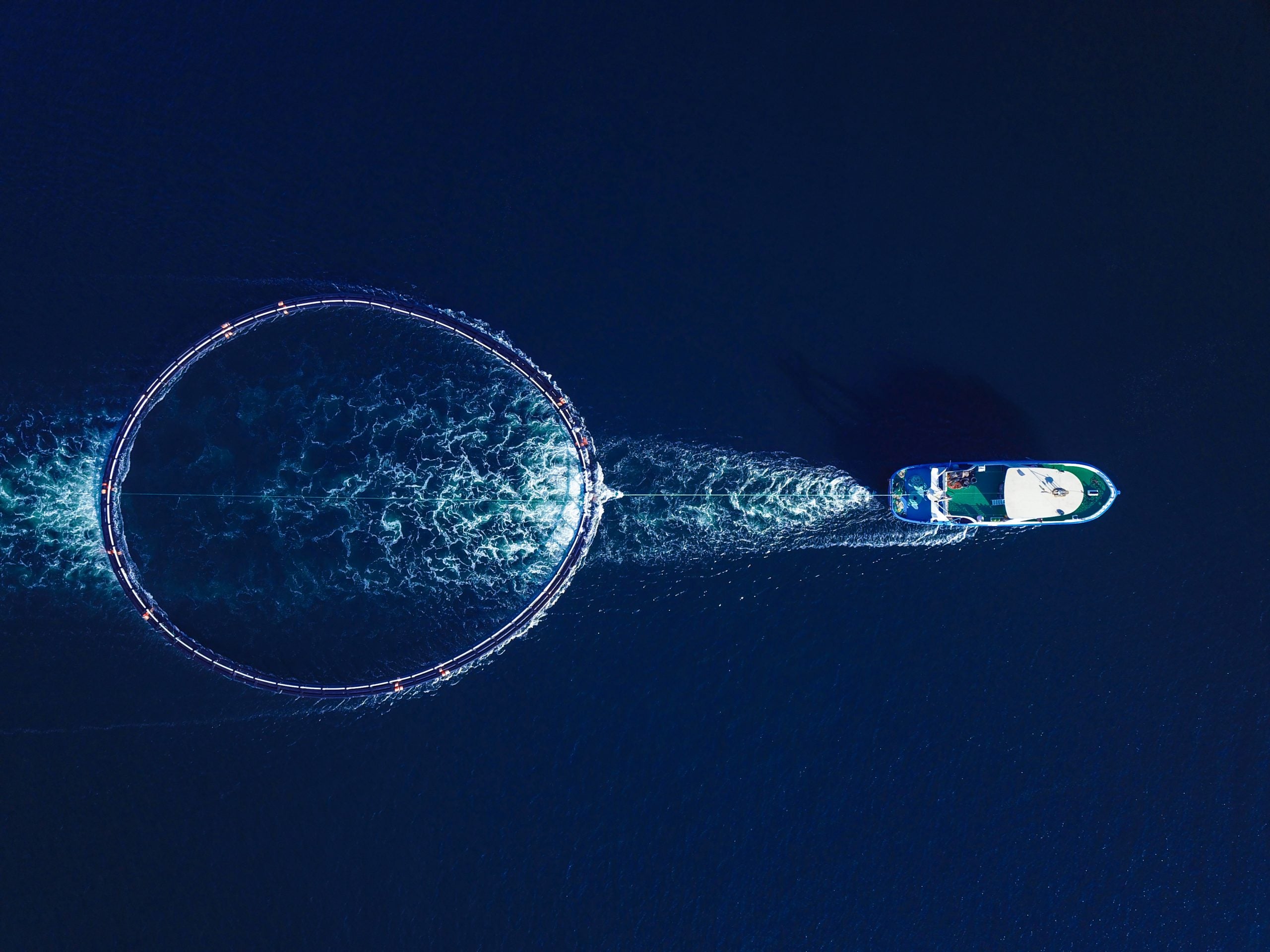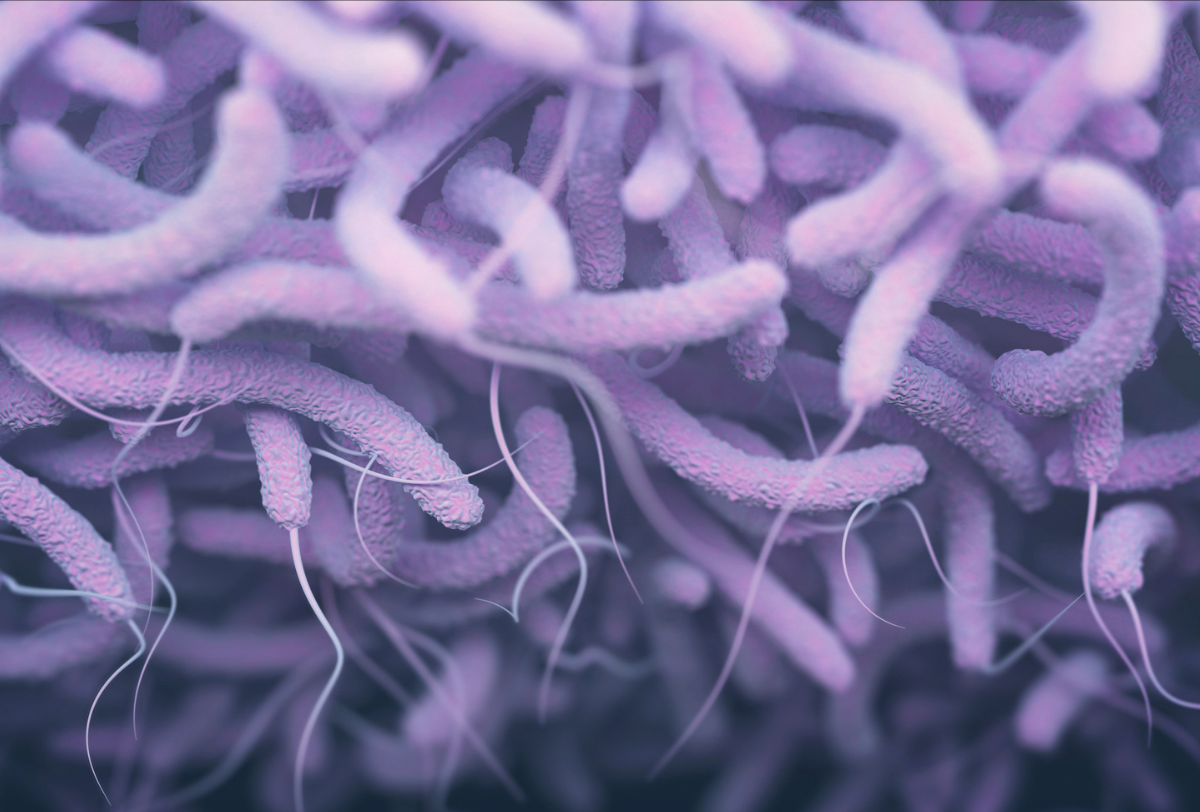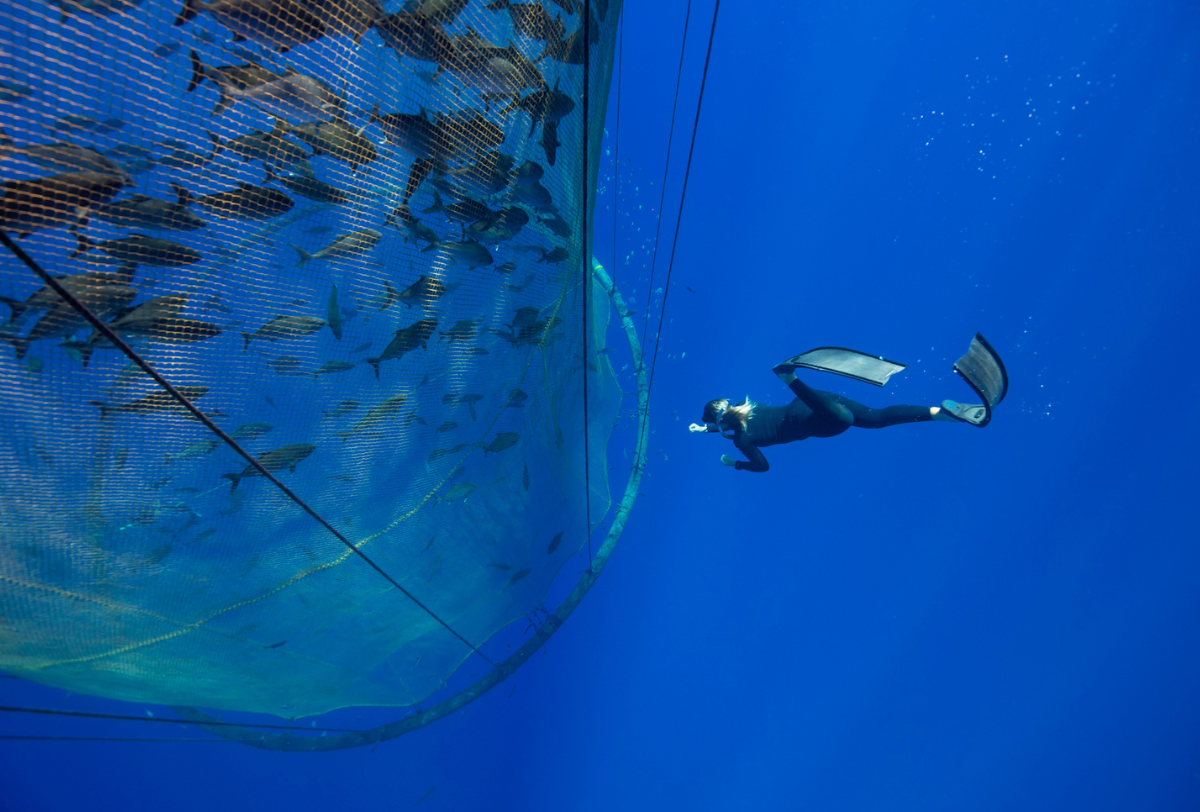Expert Q&A: What we need to know to ensure aquaculture in offshore US waters is done right
As global populations grow and fish populations shift or even shrink, one thing is clear: offshore aquaculture in the United States is a matter of when not if. But it’s also a matter of how. Because as demand for safe, delicious, low-carbon seafood grows, we must also ensure that offshore seafood farming in United States waters does not negatively impact marine ecosystems or wild capture fisheries. And according to a new report, Toward an environmentally responsible offshore aquaculture industry in the United States: Ecological risks, remedies, and knowledge gaps, building a robust regulatory framework to ensure that requires more studies and more data.
We talked to some of the report’s authors to better understand what we know, what we need to know, and where we go from here:
Matthew Thompson, Aquaculture Programs Manager at the Anderson Cabot Center for Ocean Life
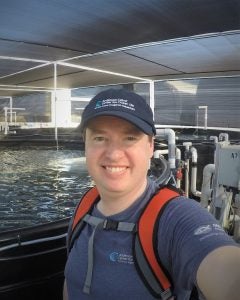
Aquaculture Programs Manager
Anderson Cabot Center for Ocean Life
QUESTION: What are the critical knowledge gaps we need to address to determine the risk of aquaculture development offshore to ocean wildlife?
MATT: Wildlife may interact with offshore aquaculture gear and operations in many ways, including some positive (e.g., utilizing as habitat) and some negative (e.g., becoming entangled), and these interactions may be highly specific to each species, location, and aquaculture gear type used. The risk of harmful interactions between endangered, threatened, or protected (ETP) species (e.g., marine mammals and sea turtles) and offshore aquaculture could present a significant obstacle for permitting and social license to operate. Some of the key knowledge gaps in mitigating risks to ETP species could be filled by precision models and simulators. For example, models of ETP species’ spatial and temporal use of ocean space that effectively account for climate-driven changes in species distributions could help identify sites or areas with a lower risk of interactions occurring. For ETP species with higher entanglement risk, measures may also be lacking to reduce the harm resulting from negative interactions. One possible solution could be using simulations to evaluate these concerns while also safely testing and validating potential mitigation measures before putting gear in the water. New innovations and innovators welcome!
QUESTION: Do you believe we can develop offshore aquaculture infrastructure, including new advancements in technology and monitoring, in a way that protects marine life?
MATT: The mission of the Anderson Cabot Center for Ocean Life at the New England Aquarium (ACCOL) is to ensure humans use the ocean responsibly, achieving a balance between development and the conservation of marine ecosystems and wildlife. Offshore aquaculture has great potential to provide more domestic food with relatively low environmental impact, and we want to help it grow responsibly. There are two main ways to reduce the risk of harmful interactions (e.g., entanglements) with ETP species: siting aquaculture operations in areas with low risk of interactions and gear solutions that reduce harm should interactions occur. ACCOL is actively working on the first element, developing more precise modeling tools to show when and where protected species with elevated entanglement risk are using the marine environment. These tools could help inform siting in aquaculture as well as other industries, such as offshore wind, to reduce the risk of interactions. In terms of gear, we encourage the protected species community, ocean engineers, blue technology pioneers and industry to come together to design and safely test solutions that can both survive in offshore conditions and mitigate interactions with ETP species (e.g., using physics-based simulators to understand a species behavioral response to gear, evaluate the risks of the current gear and evaluate gear modifications, alternatives, and new technologies). Combining these efforts would reduce the risk to wildlife, build trust in solutions, and benefit the industry with an easier path to permitting.
Taylor Voorhees, Sustainability Lead – Cargill Aqua Nutrition
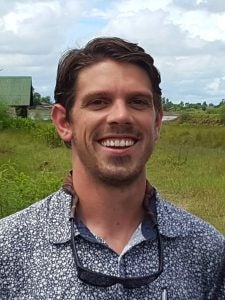
Sustainability Lead
Cargill Aqua Nutrition
QUESTION: What are the critical knowledge gaps we need to address to determine how to optimize feed best to reduce impacts on marine, freshwater and terrestrial ecosystems?
TAYLOR: There are some important technical challenges that feed and fish producers face, such as full traceability on all raw materials and having recent and specific emissions data for those materials, but we’ve taken a more contemplative approach to this question in the paper. The gaps we highlight collectively implore us – as aquaculture stakeholders – to consider what sustainability topics are most important and, for each topic, what level of impact we deem acceptable as a trade-off for the production of food (and of jobs). Feed optimization is especially complex because of its compound nature, with many dozens of ingredients commonly used, each from raw materials grown or caught in a variety of places. Each has benefits and costs of production and use, and our great challenge is determining how we value those benefits and costs.
For example, some stakeholders want to see feeds with very low marine ingredient inclusions and some (or even the same) stakeholders want to see feed with very low greenhouse gas emissions. Still, because marine ingredients are generally less emissions-intensive than the crop-derived ingredients that replace them, tension exists between these desired outcomes. To optimize feed to reduce impacts on those diverse ecosystems, the industry’s stakeholders must collectively decide our priorities, our acceptable levels of impact, and how we’ll use investments and the market to achieve progress. The knowledge gaps we report in the paper – like which metrics should we use to measure and monitor feed sustainability and how the consequences of current and future ingredients compare – are refined aspects of this broader need to agree on what we’re working towards.
QUESTION: What data or research is needed to ensure feed is low-carbon and includes cost-effective ingredients?
TAYLOR: The carbon and the cost aspects have distinct but very related needs. To ensure the feeds we make are low-carbon, we need better primary data on the actual emissions resulting from ingredient production. The majority of a feed’s carbon footprint lies in the production of raw materials, not in the transportation of ingredients or the energy it takes to make the feed. Still, unfortunately, emissions stemming from raw material production are the most difficult data to obtain. Even some of the best data we have, such as that compiled by the Global Feed LCA Institute, are broad national averages and can be a decade old. Canadian wheat, for example, isn’t just Canadian wheat: each farm’s soil types and production practices and a given year’s weather conditions can all result in a considerable variation in the emissions embedded in that wheat production. So, greatly expanding our data collection from fields and fisheries – and ensuring our traceability systems allow those data to accompany the materials they represent – is key to understanding feed emissions. This is the foundation for the necessary next step: working with producers to drive those emissions down.
For cost-effectiveness, I have competing economic theories in my head about how low-carbon feeds (or, more broadly, more sustainable anything) should be positioned in the market. Should low-carbon feeds be more expensive because they are more valuable to us? Or should high-carbon feeds be more expensive to create an economic incentive away from them? Ultimately, a research agenda focused on what aquaculture supply chains are willing to pay for products of varying sustainability characteristics would help the industry continue advancing its sustainability. It would make sense to begin at the terminal ends of the chain – consumers at retail and restaurants – and work backward, but understanding how the value of more sustainable feeds could be positioned and distributed throughout the chain would give feed producers more confidence in our investments to both reduce the impact of ingredients we already use and support the development of new ones.
QUESTION: Are you optimistic that we can develop offshore aquaculture in a way that is sustainable through feed improvements?
TAYLOR: I’m highly optimistic that feed can be an integral component of a sustainable offshore aquaculture industry. Remember, an industry’s sustainability is determined by the success of its fish health management measures, escape mitigation efforts, provision of safe and fair employment, and many other things. Where farming takes place, a thorough understanding of the ecosystem’s carrying capacity and setting production and performance targets in alignment with that is paramount.
Feed, however, is uniquely important because it is a direct driver and connector of the sustainability of farms and the sustainability of fisheries and other agriculture production that enable farm production. At Cargill, for example, we see this both as a responsibility and an opportunity, and we’re working on many types of feed improvements to support the industry’s sustainability now and into the future. For improvements at farm sites, feeds are engineered to deliver the proper nutrition at the right time throughout the production cycle. This results in greater digestibility and, therefore, less particulate waste and immune-support feeds boost the health and welfare of fish, so they grow according to their potential. Development of site-specific, data-driven biomass models allows accurate predictions for how much and of what types of feed the fish will need – this ensures we don’t make or deliver too much. For example, in-situ technologies allow farmers to deliver and monitor feed, so that feed waste is nearly eliminated. For improvements up the value chain, at the locations where the feed ingredients are grown or caught, we have tremendous momentum in work to calculate and reduce the emissions from production, to ensure and expand sustainable fisheries management, and to develop new and more circular ingredients.
There is so much focus on improving the sustainability of today’s feeds and making our dreams of tomorrow’s feeds a reality. With the global aquaculture industry’s growth expectations – including in offshore environments – this focus has never been more critical. It leaves me highly optimistic that we’ll continue to see improvements in feed and the integral role that sustainable feeds will play in developing a sustainable offshore industry.
Rod Fujita, Senior Scientist at Environmental Defense Fund
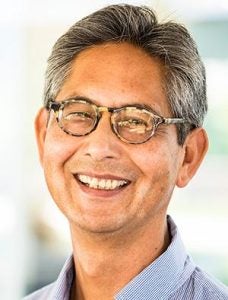
AVP, Research & Development, Lead Senior Scientist
Environmental Defense Fund
QUESTION: What lessons can we learn from nearshore aquaculture practices and existing offshore pilot projects that we can apply to offshore aquaculture?
ROD: Great progress has been made toward reducing ecological impacts of aquaculture. Although this progress has been mixed, highlights include large improvements in feed conversion and fish-in/fish-out ratios for some very well-studied farmed species, reductions in antibiotic use and improvements in animal containment technologies and practices. Advances in selective breeding, fish nutrition, the use of alternative ingredients in feeds, precision farming (careful calibration of feeding rates to minimize waste) and other good practices will probably carry over into offshore aquaculture.
QUESTION: What are some of the most critical unanswered questions that will require more research to create a regulatory framework for offshore aquaculture in the U.S.?
ROD: Offshore aquaculture will no doubt benefit from the advances in selective breeding, fish nutrition and the use of alternative ingredients to reduce the use of fishmeal and fish oil in feeds. However, more research will be required to improve feed conversion and fish-in/fish-out ratios if novel or under-studied species are farmed offshore. Improved farming practices that help prevent escapement will likely be adopted offshore, but of course, some modifications will be required because of some important differences in wave height, current speed and other environmental conditions. Advances in remote monitoring and control technologies may be required to make offshore aquaculture more cost-effective and to provide data for accountability purposes. A greater understanding of the assimilative capacity or ecosystem thresholds in offshore ecosystems and how they can be applied to offshore aquaculture will be required, as they are likely to be quite different offshore compared to the freshwater and nearshore environments – in which almost all aquaculture currently occurs. For example, benthic impacts are relevant in shallow nearshore waters but probably not offshore, where very rapid assimilation of waste products can occur, resulting in different impacts on different biological communities.
QUESTION: What are the benefits of doing the research called for in the gap analysis paper before developing a regulatory framework?
ROD: Typically, industries that depend on good environmental quality develop based on certain beliefs about ecological risk and thresholds for ecosystem damage rather than on evidence. While industrial activity remains limited in scale, these risks are low and impacts are imperceptible. However, as industrial activity increases, dramatic problems can arise “suddenly” because limited research was done to anticipate them. This can result in crisis management, which increases costs to the environment, industry and society at large. Because offshore aquaculture is a nascent industry, we have a rare opportunity to set it on a path toward sustainability based on a scientific understanding of ecological risks and thresholds for ecosystem damage, as well as an understanding of how best to mitigate those risks, rather than on beliefs – helping to prevent crises and crisis management.










